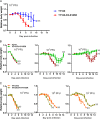Amino acid changes in the influenza A virus PA protein that attenuate avian H5N1 viruses in mammals
- PMID: 25231317
- PMCID: PMC4248959
- DOI: 10.1128/JVI.01081-14
Amino acid changes in the influenza A virus PA protein that attenuate avian H5N1 viruses in mammals
Abstract
The influenza viral polymerase complex affects host tropism and pathogenicity. In particular, several amino acids in the PB2 polymerase subunit are essential for the efficient replication of avian influenza viruses in mammals. The PA polymerase subunit also contributes to host range and pathogenicity. Here, we report that the PA proteins of several highly pathogenic avian H5N1 viruses have attenuating properties in mammalian cells and that the attenuating phenotype is conferred by strain-specific amino acid changes. Specifically, lysine at position 185 of A/duck/Vietnam/TY165/2010 (TY165; H5N1) PA induced strongly attenuating effects in vitro and in vivo. More importantly, the introduction of the arginine residue commonly found at this position in PA significantly increased the viral polymerase activity of TY165 in mammalian cells and its virulence and pathogenicity in mice. These findings demonstrate that the PA protein plays an important role in influenza virulence and pathogenicity.
Importance: Highly pathogenic influenza viruses of the H5N1 subtype cause severe respiratory infections in humans, which have resulted in death in nearly two-thirds of the patients with laboratory-confirmed cases. We found that the viral PA polymerase subunit of several H5N1 viruses possesses amino acid changes that attenuate virus replication in mammalian cells (yet the H5N1 viruses possessing these mutations are highly pathogenic in mice). Specifically, we found that an arginine-to-lysine substitution at position 185 of an H5N1 virus PA protein significantly affected that virus's virulence and pathogenicity in mice. The PA protein thus plays a role in the pathogenicity of highly pathogenic H5N1 influenza viruses.
Copyright © 2014, American Society for Microbiology. All Rights Reserved.
Figures







Similar articles
-
NP body domain and PB2 contribute to increased virulence of H5N1 highly pathogenic avian influenza viruses in chickens.J Virol. 2011 Feb;85(4):1834-46. doi: 10.1128/JVI.01648-10. Epub 2010 Dec 1. J Virol. 2011. PMID: 21123376 Free PMC article.
-
PA Mutations Inherited during Viral Evolution Act Cooperatively To Increase Replication of Contemporary H5N1 Influenza Virus with an Expanded Host Range.J Virol. 2020 Dec 9;95(1):e01582-20. doi: 10.1128/JVI.01582-20. Print 2020 Dec 9. J Virol. 2020. PMID: 33028722 Free PMC article.
-
The PB2, PA, HA, NP, and NS genes of a highly pathogenic avian influenza virus A/whooper swan/Mongolia/3/2005 (H5N1) are responsible for pathogenicity in ducks.Virol J. 2013 Feb 2;10:45. doi: 10.1186/1743-422X-10-45. Virol J. 2013. PMID: 23374292 Free PMC article.
-
[Clue to the molecular mechanism of virulence of highly pathogenic H5N1 avian influenza viruses isolated in 2004].Uirusu. 2005 Jun;55(1):55-61. doi: 10.2222/jsv.55.55. Uirusu. 2005. PMID: 16308530 Review. Japanese.
-
PA and PA-X: two key proteins from segment 3 of the influenza viruses.Front Cell Infect Microbiol. 2025 Mar 14;15:1560250. doi: 10.3389/fcimb.2025.1560250. eCollection 2025. Front Cell Infect Microbiol. 2025. PMID: 40160474 Free PMC article. Review.
Cited by
-
Wild Bird-Origin H6N2 Influenza Virus Acquires Enhanced Pathogenicity after Single Passage in Mice.Viruses. 2024 Feb 25;16(3):357. doi: 10.3390/v16030357. Viruses. 2024. PMID: 38543722 Free PMC article.
-
H7N9 Influenza Virus Containing a Polybasic HA Cleavage Site Requires Minimal Host Adaptation to Obtain a Highly Pathogenic Disease Phenotype in Mice.Viruses. 2020 Jan 5;12(1):65. doi: 10.3390/v12010065. Viruses. 2020. PMID: 31948040 Free PMC article.
-
The R251K Substitution in Viral Protein PB2 Increases Viral Replication and Pathogenicity of Eurasian Avian-like H1N1 Swine Influenza Viruses.Viruses. 2020 Jan 2;12(1):52. doi: 10.3390/v12010052. Viruses. 2020. PMID: 31906472 Free PMC article.
-
Amino acid substitutions in low pathogenic avian influenza virus strains isolated from wild birds in Korea.Virus Genes. 2018 Jun;54(3):397-405. doi: 10.1007/s11262-018-1550-7. Epub 2018 Mar 26. Virus Genes. 2018. PMID: 29582231
-
Glycine at Position 622 in PB1 Contributes to the Virulence of H5N1 Avian Influenza Virus in Mice.J Virol. 2015 Dec 9;90(4):1872-9. doi: 10.1128/JVI.02387-15. Print 2016 Feb 15. J Virol. 2015. PMID: 26656683 Free PMC article.
References
-
- Yamada S, Hatta M, Staker BL, Watanabe S, Imai M, Shinya K, Sakai-Tagawa Y, Ito M, Ozawa M, Watanabe T, Sakabe S, Li C, Kim JH, Myler PJ, Phan I, Raymond A, Smith E, Stacy R, Nidom CA, Lank SM, Wiseman RW, Bimber BN, O'Connor DH, Neumann G, Stewart LJ, Kawaoka Y. 2010. Biological and structural characterization of a host-adapting amino acid in influenza virus. PLoS Pathog. 6:e1001034. 10.1371/journal.ppat.1001034. - DOI - PMC - PubMed
Publication types
MeSH terms
Substances
Grants and funding
LinkOut - more resources
Full Text Sources
Other Literature Sources
Medical

